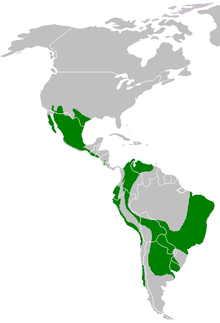| Harris's hawk | |
|---|---|

| |
| Scientific classification | |
| Domain: | Eukaryota |
| Kingdom: | Animalia |
| Phylum: | Chordata |
| Class: | Aves |
| Order: | Accipitriformes |
| Family: | Accipitridae |
| Genus: | Parabuteo |
| Species: | P. unicinctus
|
| Binomial name | |
| Parabuteo unicinctus (Temminck, 1824)
| |
| Subspecies | |
|
P. u. harrisi | |

| |
| Distribution map of Parabuteo unicinctus | |
| Synonyms[2] | |
|
Falco harrisii Audubon 1839 | |
Harris's hawk (Parabuteo unicinctus), formerly known as the bay-winged hawk or dusky hawk, and known in Latin America as the peuco, is a medium-large bird of prey that breeds from the southwestern United States south to Chile, central Argentina, and Brazil. This bird is sometimes reported to be at large in Western Europe, especially Britain, but it is a popular species in falconry and these records almost invariably all refer to escapes from captivity.
The name is derived from the Greek para, meaning beside, near or like, and the Latin buteo, referring to a kind of buzzard; uni meaning once; and cinctus meaning girdled, referring to the white band at the tip of the tail.[3] John James Audubon gave this bird its English name in honor of his ornithological companion, financial supporter, and friend Edward Harris.[4]
Harris's hawk is notable for its behavior of hunting cooperatively in packs consisting of tolerant groups, while other raptors often hunt alone. Harris's hawks' social nature has been attributed to their intelligence, which makes them easy to train and has made them a popular bird for use in falconry.[5]
- ^ BirdLife International (2016). "Parabuteo unicinctus". IUCN Red List of Threatened Species. 2016: e.T22695838A93529685. doi:10.2305/IUCN.UK.2016-3.RLTS.T22695838A93529685.en. Retrieved 19 November 2021.
- ^ Cite error: The named reference
Sharpe1874was invoked but never defined (see the help page). - ^ Jobling, James A. (1991). A Dictionary of Scientific Bird Names. Oxford University Press. ISBN 978-0-19-854634-4.
- ^ National Audubon Society. "Audubon". Audubon. Archived from the original on 2008-04-09. Retrieved 2013-04-29.
- ^ Beebe, Frank (1984). A Falconry Manual. Hancock House Publishers, ISBN 0-88839-978-2, page 81.
